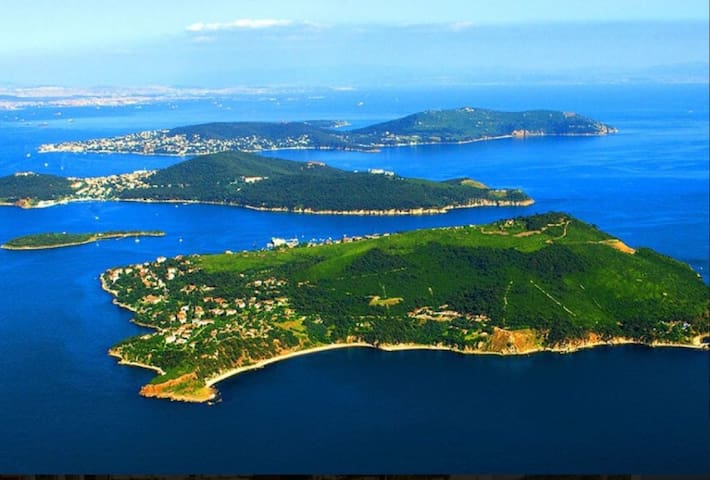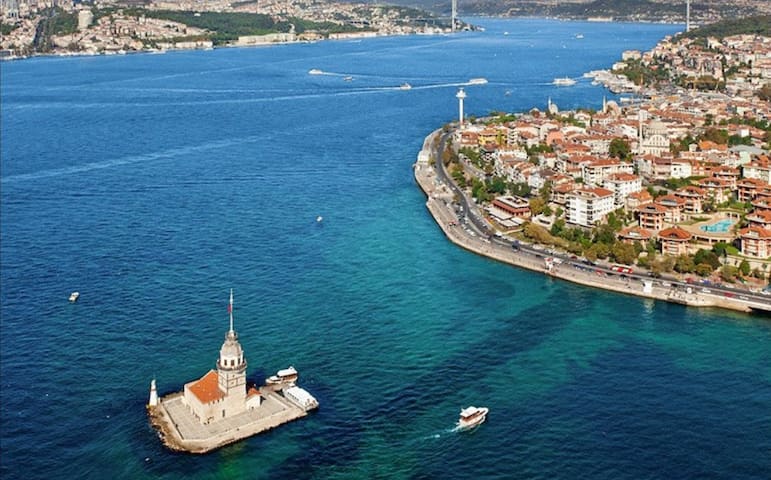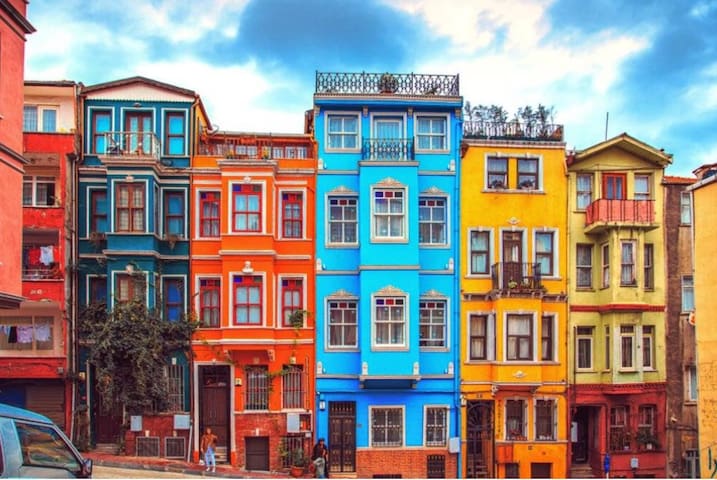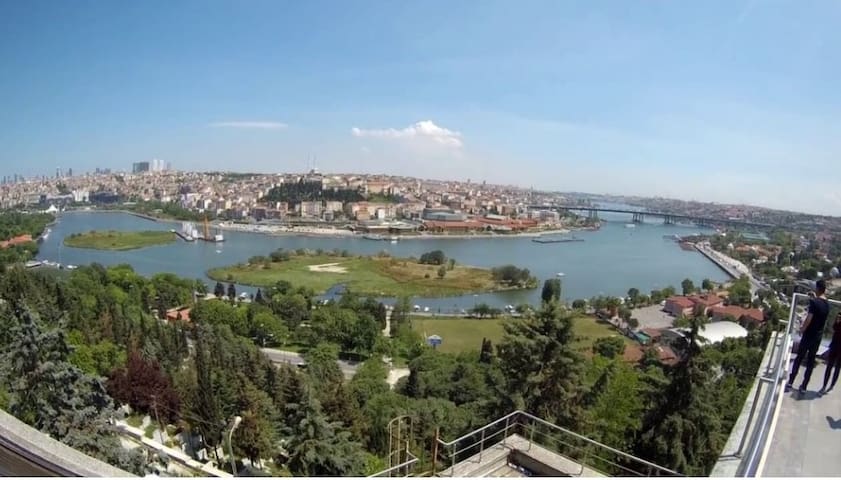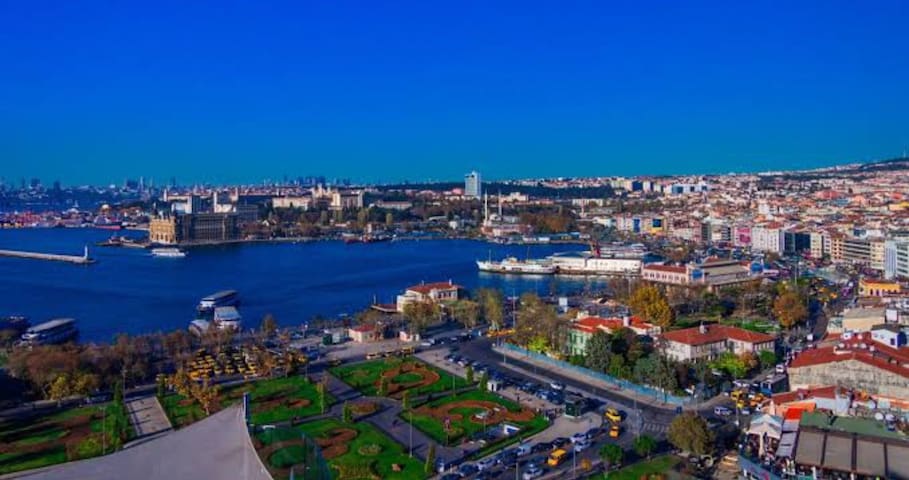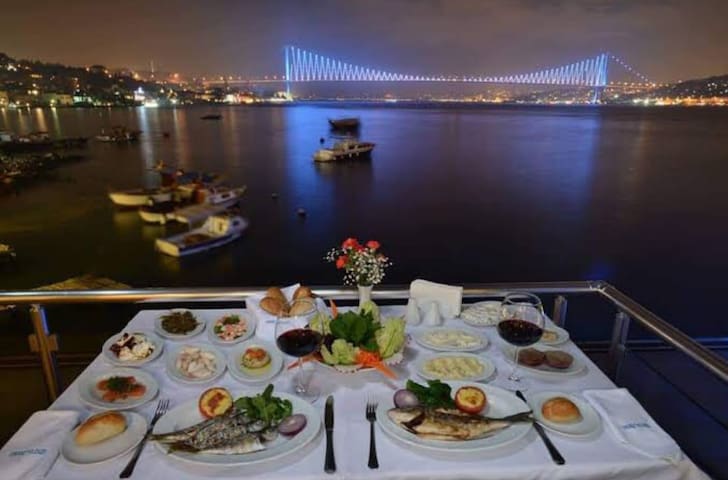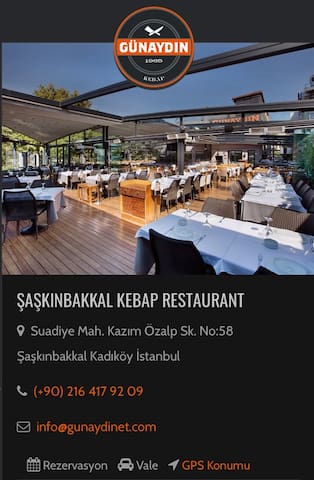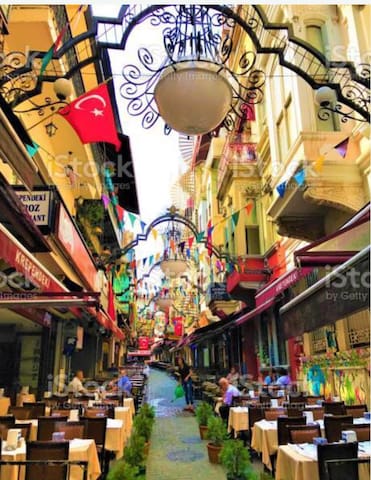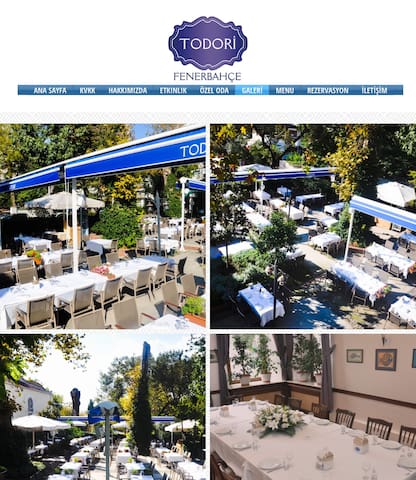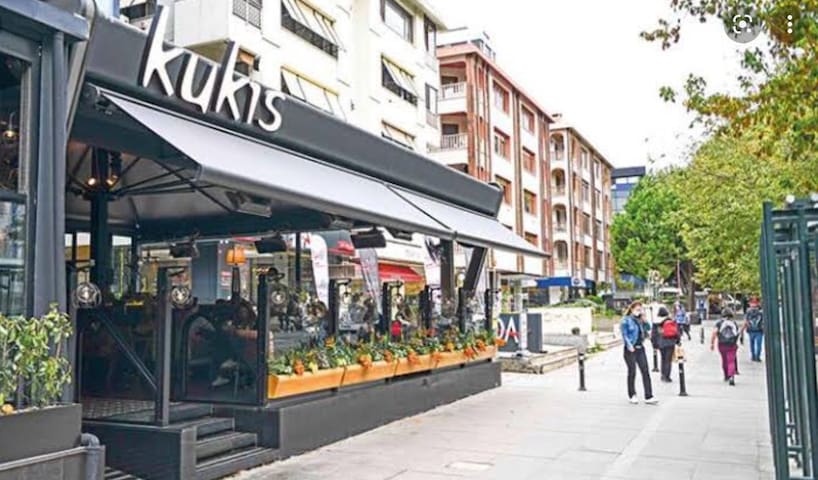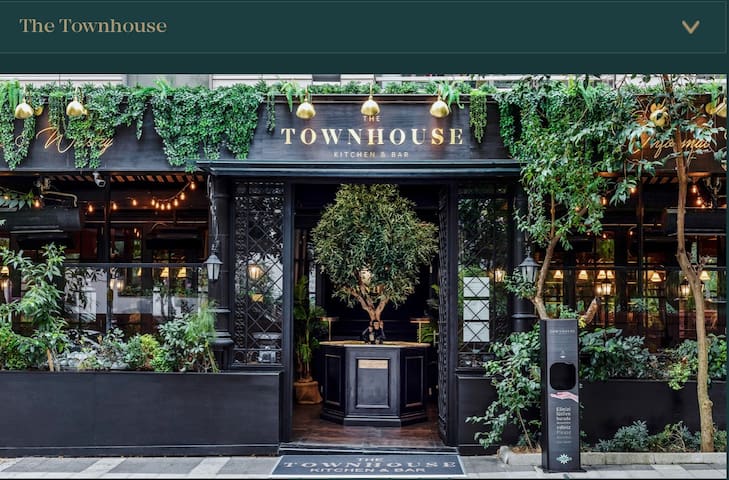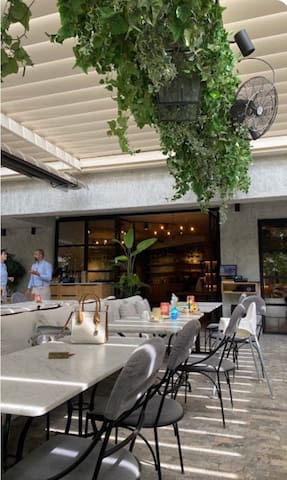Gezilecek yerler
Travel by boat from Istanbul to Heybeli Island and Büyükada. See Ottoman-era mansions, enjoy lunch while on the sea, and enjoy free time to explore.
171 personas del lugar lo recomiendan
Büyükada
Travel by boat from Istanbul to Heybeli Island and Büyükada. See Ottoman-era mansions, enjoy lunch while on the sea, and enjoy free time to explore.
Gran Bazar
Beyazıt CaddesiShopping&Food
Üsküdar
Shopping/Sightseeing / Food
Visit Istanbul: Beyoğlu district
During your stay, you cannot miss the visit of the neighborhoods that make up the Beyoğlu district. Especially famous for the square of Taksim and the great pedestrian avenue of Istiklal, Beyoğlu which extends to the entrance of the Golden Horn in front of the bridge of Galata is much more than that.
Composed of a great variety and diversity of neighborhoods of which the most famous are Galata, Cihangir, or Karaköy, this area is fundamental in the history of Istanbul. Symbol of the heyday of Constantinople, but also of the decline of Istanbul in the 90s, it is the thermometer of the city. To understand Beyoğlu is to understand the history of the city and its actuality.
One of the first places that recall the importance of this area, is the district of Karaköy where you will find the imposing Banks Street (Bankalar Caddesi) which symbol is the former headquarters of the Imperial Ottoman Bank. Designed by the famous architect Alexandre Vallaury, this imposing building with its neo-classical and neo-Renaissance facade bears witness to the glorious past of the Empire.
132 personas del lugar lo recomiendan
Beyoğlu
Visit Istanbul: Beyoğlu district
During your stay, you cannot miss the visit of the neighborhoods that make up the Beyoğlu district. Especially famous for the square of Taksim and the great pedestrian avenue of Istiklal, Beyoğlu which extends to the entrance of the Golden Horn in front of the bridge of Galata is much more than that.
Composed of a great variety and diversity of neighborhoods of which the most famous are Galata, Cihangir, or Karaköy, this area is fundamental in the history of Istanbul. Symbol of the heyday of Constantinople, but also of the decline of Istanbul in the 90s, it is the thermometer of the city. To understand Beyoğlu is to understand the history of the city and its actuality.
One of the first places that recall the importance of this area, is the district of Karaköy where you will find the imposing Banks Street (Bankalar Caddesi) which symbol is the former headquarters of the Imperial Ottoman Bank. Designed by the famous architect Alexandre Vallaury, this imposing building with its neo-classical and neo-Renaissance facade bears witness to the glorious past of the Empire.
The World’s First Underground Cruise Ship Terminal
Positioned as a homeport, Galataport Istanbul is a world-class cruise ship port that is set to vitalize cruise tourism across an extensive region from the Mediterranean basin to the Black Sea. An exemplary project worldwide and a groundbreaking innovation thanks to its special hatch system that enables the terminal to be placed underground, Galataport Istanbul is transforming the Karaköy coastline, which had been closed to public access for a long time, into one of the best promenades in the city.
The hatch system separates the customs and security (ISPS) areas when there is no ship berthed at the port creating a temporary customs area and keeping the promenade open to public.
164 personas del lugar lo recomiendan
Puertos de Galataport
The World’s First Underground Cruise Ship Terminal
Positioned as a homeport, Galataport Istanbul is a world-class cruise ship port that is set to vitalize cruise tourism across an extensive region from the Mediterranean basin to the Black Sea. An exemplary project worldwide and a groundbreaking innovation thanks to its special hatch system that enables the terminal to be placed underground, Galataport Istanbul is transforming the Karaköy coastline, which had been closed to public access for a long time, into one of the best promenades in the city.
The hatch system separates the customs and security (ISPS) areas when there is no ship berthed at the port creating a temporary customs area and keeping the promenade open to public.
OTTOMAN IMPERIAL PALACE
it served as the main residence and administrative headquarters of the Ottoman sultans:
Topkapı Palace and Harem (Topkapı Sarayı) are likely to have more colourful stories than most of the world's museums put together. Libidinous sultans, ambitious courtiers, beautiful concubines and scheming eunuchs lived and worked here between the 15th and 19th centuries when it was the court of the Ottoman empire. A visit to the palace's opulent pavilions, jewel-filled Treasury and sprawling Harem gives a fascinating glimpse into their lives.
It has many exhibion halls, Treasury section, and Harem.
Mehmet the Conqueror built the first stage of the palace shortly after the Conquest in 1453, and lived here until his death in 1481. Subsequent sultans lived in this rarefied environment until the 19th century, when they moved to the ostentatious European-style palaces they built on the shores of the Bosphorus.Before you enter the palace's Imperial Gate (Bab-ı Hümayun), take a look at the ornate structure in the cobbled square just outside. This is the rococo-style Fountain of Sultan Ahmet III, built in 1728 by the sultan who so favoured tulips. The main ticket office is in the First Court, just before the gate to the Second Court.
Topkapi Palace was home to all the Ottoman sultans until the reign of Abdulmecid I (1839-1860), a period of nearly four centuries.
7 personas del lugar lo recomiendan
Topkapı Palace
Topkapı SarayıOTTOMAN IMPERIAL PALACE
it served as the main residence and administrative headquarters of the Ottoman sultans:
Topkapı Palace and Harem (Topkapı Sarayı) are likely to have more colourful stories than most of the world's museums put together. Libidinous sultans, ambitious courtiers, beautiful concubines and scheming eunuchs lived and worked here between the 15th and 19th centuries when it was the court of the Ottoman empire. A visit to the palace's opulent pavilions, jewel-filled Treasury and sprawling Harem gives a fascinating glimpse into their lives.
It has many exhibion halls, Treasury section, and Harem.
Mehmet the Conqueror built the first stage of the palace shortly after the Conquest in 1453, and lived here until his death in 1481. Subsequent sultans lived in this rarefied environment until the 19th century, when they moved to the ostentatious European-style palaces they built on the shores of the Bosphorus.Before you enter the palace's Imperial Gate (Bab-ı Hümayun), take a look at the ornate structure in the cobbled square just outside. This is the rococo-style Fountain of Sultan Ahmet III, built in 1728 by the sultan who so favoured tulips. The main ticket office is in the First Court, just before the gate to the Second Court.
Topkapi Palace was home to all the Ottoman sultans until the reign of Abdulmecid I (1839-1860), a period of nearly four centuries.
Beylerbeyi Palace was commissioned by Sultan Abdülaziz (1830–1876) and built between 1861 and 1865 as a summer residence and a place to entertain visiting heads of state. Empress Eugénie of France visited Beylerbeyi on her way to the opening of the Suez Canal in 1869. Empress Eugénie of France was so delighted by the elegance of the palace that she had a copy of the window in the guest room made for her bedroom in Tuileries Palace, in Paris. Naser al-Din Shah Qajar of Iran stayed in the palace while he was in Istanbul, back on his way from Exposition Universelle (1889) of France. Other regal visitors to the palace included the Duke and Duchess of Windsor.
The palace was the last place of captivity of the deposed sultan Abdulhamid II from 1912 until his death there in 1918
92 personas del lugar lo recomiendan
Túnel histórico del Palacio de Beylerbeyi
Abdullahağa CaddesiBeylerbeyi Palace was commissioned by Sultan Abdülaziz (1830–1876) and built between 1861 and 1865 as a summer residence and a place to entertain visiting heads of state. Empress Eugénie of France visited Beylerbeyi on her way to the opening of the Suez Canal in 1869. Empress Eugénie of France was so delighted by the elegance of the palace that she had a copy of the window in the guest room made for her bedroom in Tuileries Palace, in Paris. Naser al-Din Shah Qajar of Iran stayed in the palace while he was in Istanbul, back on his way from Exposition Universelle (1889) of France. Other regal visitors to the palace included the Duke and Duchess of Windsor.
The palace was the last place of captivity of the deposed sultan Abdulhamid II from 1912 until his death there in 1918
Basilica Cistern(Yerebatan Sarnıcı)
Meet your guide in front of the exit gate of the Basilica Cistern, skip the long lines and visit the ancient water cistern built in 336. Admire the stunning architecture of this marvel of engineering on a guided highlights tour. After your tour, you can stay inside as long as you want and discover the Basilica Cistern at your own pace.
638 personas del lugar lo recomiendan
Cisterna Basílica
1/3 Yerebatan Cd.Basilica Cistern(Yerebatan Sarnıcı)
Meet your guide in front of the exit gate of the Basilica Cistern, skip the long lines and visit the ancient water cistern built in 336. Admire the stunning architecture of this marvel of engineering on a guided highlights tour. After your tour, you can stay inside as long as you want and discover the Basilica Cistern at your own pace.
The Egyptian Bazaar is located in the Eminönü district of İstanbul, behind Yeni Mosque and adjacent to the Flower Market. One of the oldest covered bazaars in İstanbul, the Egyptian Bazaar was indeed founded with the intention of monetary assistance to Yeni Mosque during its construction. Initiated by Safiye Sultan, mother of Sultan Murat III., in 10 Muharram 1006 (1957), the construction was completed by Hatice Turhan Sultan, mother of Sultan Murat IV., after a long period of stagnation. The architects were Davut Aga and Mustafa Aga.
Spice Bazaar was lastly restored extensively by General Directorate of Foundations between 2013 and 2018.
449 personas del lugar lo recomiendan
Mısır Çarşısı
92 Erzak Ambarı Sok.The Egyptian Bazaar is located in the Eminönü district of İstanbul, behind Yeni Mosque and adjacent to the Flower Market. One of the oldest covered bazaars in İstanbul, the Egyptian Bazaar was indeed founded with the intention of monetary assistance to Yeni Mosque during its construction. Initiated by Safiye Sultan, mother of Sultan Murat III., in 10 Muharram 1006 (1957), the construction was completed by Hatice Turhan Sultan, mother of Sultan Murat IV., after a long period of stagnation. The architects were Davut Aga and Mustafa Aga.
Spice Bazaar was lastly restored extensively by General Directorate of Foundations between 2013 and 2018.
Originally built by the eastern Roman emperor Justinian I as the Christian cathedral of Constantinople for the state church of the Roman Empire between 532 and 537, and designed by the Greek geometers Isidore of Miletus and Anthemius of Tralles,[4] it was formally called the Church of the Holy Wisdom (Greek: Ναὸς τῆς Ἁγίας τοῦ Θεοῦ Σοφίας, romanized: Naòs tês Hagías toû Theoû Sophías)[5] and was then the world's largest interior space and among the first to employ a fully pendentive dome. It is considered the epitome of Byzantine architecture[6] and is said to have "changed the history of architecture".[7] The present Justinianic building was the third church of the same name to occupy the site, as the prior one had been destroyed in the Nika riots. As the episcopal see of the ecumenical patriarch of Constantinople, it remained the world's largest cathedral for nearly a thousand years, until Seville Cathedral was completed in 1520. Beginning with subsequent Byzantine architecture, Hagia Sophia became the paradigmatic Orthodox church form, and its architectural style was emulated by Ottoman mosques a thousand years later.[8] It has been described as "holding a unique position in the Christian world"[8] and as an architectural and cultural icon of Byzantine and Eastern Orthodox civilization.[9][10][8]
The religious and spiritual centre of the Eastern Orthodox Church for nearly one thousand years, the church was dedicated to the Holy Wisdom.[11][12][13] It was where the excommunication of Patriarch Michael I Cerularius was officially delivered by Humbert of Silva Candida, the envoy of Pope Leo IX in 1054, an act considered the start of the East–West Schism. In 1204, it was converted during the Fourth Crusade into a Catholic cathedral under the Latin Empire, before being returned to the Eastern Orthodox Church upon the restoration of the Byzantine Empire in 1261. The doge of Venice who led the Fourth Crusade and the 1204 Sack of Constantinople, Enrico Dandolo, was buried in the church.
After the Fall of Constantinople to the Ottoman Empire in 1453,[14] it was converted to a mosque by Mehmed the Conqueror and became the principal mosque of Istanbul until the 1616 construction of the Sultan Ahmed Mosque.[15][16] Upon its conversion, the bells, altar, iconostasis, ambo, and baptistery were removed, while iconography, such as the mosaic depictions of Jesus, Mary, Christian saints and angels were removed or plastered over.[17] Islamic architectural additions included four minarets, a minbar and a mihrab. The Byzantine architecture of the Hagia Sophia served as inspiration for many other religious buildings including the Hagia Sophia in Thessaloniki, Panagia Ekatontapiliani, the Şehzade Mosque, the Süleymaniye Mosque, the Rüstem Pasha Mosque and the Kılıç Ali Pasha Complex. The patriarchate moved to the Church of the Holy Apostles, which became the city's cathedral.
The complex remained a mosque until 1931, when it was closed to the public for four years. It was re-opened in 1935 as a museum under the secular Republic of Turkey,[18] and the building was Turkey's most visited tourist attraction in 2015[19] and 2019.[20][21] In July 2020, the Council of State annulled the 1934 decision to establish the museum, and the Hagia Sophia was reclassified as a mosque.[22][23][24] The 1934 decree was ruled to be unlawful under both Ottoman and Turkish law as Hagia Sophia's waqf, endowed by Sultan Mehmed, had designated the site a mosque; proponents of the decision argued the Hagia Sophia was the personal property of the sultan.[25][26] This redesignation drew condemnation from the Turkish opposition, UNESCO, the World Council of Churches, the International Association of Byzantine Studies, and many international leaders.
1014 personas del lugar lo recomiendan
Hagia Sophia
No:1 Ayasofya MeydanıOriginally built by the eastern Roman emperor Justinian I as the Christian cathedral of Constantinople for the state church of the Roman Empire between 532 and 537, and designed by the Greek geometers Isidore of Miletus and Anthemius of Tralles,[4] it was formally called the Church of the Holy Wisdom (Greek: Ναὸς τῆς Ἁγίας τοῦ Θεοῦ Σοφίας, romanized: Naòs tês Hagías toû Theoû Sophías)[5] and was then the world's largest interior space and among the first to employ a fully pendentive dome. It is considered the epitome of Byzantine architecture[6] and is said to have "changed the history of architecture".[7] The present Justinianic building was the third church of the same name to occupy the site, as the prior one had been destroyed in the Nika riots. As the episcopal see of the ecumenical patriarch of Constantinople, it remained the world's largest cathedral for nearly a thousand years, until Seville Cathedral was completed in 1520. Beginning with subsequent Byzantine architecture, Hagia Sophia became the paradigmatic Orthodox church form, and its architectural style was emulated by Ottoman mosques a thousand years later.[8] It has been described as "holding a unique position in the Christian world"[8] and as an architectural and cultural icon of Byzantine and Eastern Orthodox civilization.[9][10][8]
The religious and spiritual centre of the Eastern Orthodox Church for nearly one thousand years, the church was dedicated to the Holy Wisdom.[11][12][13] It was where the excommunication of Patriarch Michael I Cerularius was officially delivered by Humbert of Silva Candida, the envoy of Pope Leo IX in 1054, an act considered the start of the East–West Schism. In 1204, it was converted during the Fourth Crusade into a Catholic cathedral under the Latin Empire, before being returned to the Eastern Orthodox Church upon the restoration of the Byzantine Empire in 1261. The doge of Venice who led the Fourth Crusade and the 1204 Sack of Constantinople, Enrico Dandolo, was buried in the church.
After the Fall of Constantinople to the Ottoman Empire in 1453,[14] it was converted to a mosque by Mehmed the Conqueror and became the principal mosque of Istanbul until the 1616 construction of the Sultan Ahmed Mosque.[15][16] Upon its conversion, the bells, altar, iconostasis, ambo, and baptistery were removed, while iconography, such as the mosaic depictions of Jesus, Mary, Christian saints and angels were removed or plastered over.[17] Islamic architectural additions included four minarets, a minbar and a mihrab. The Byzantine architecture of the Hagia Sophia served as inspiration for many other religious buildings including the Hagia Sophia in Thessaloniki, Panagia Ekatontapiliani, the Şehzade Mosque, the Süleymaniye Mosque, the Rüstem Pasha Mosque and the Kılıç Ali Pasha Complex. The patriarchate moved to the Church of the Holy Apostles, which became the city's cathedral.
The complex remained a mosque until 1931, when it was closed to the public for four years. It was re-opened in 1935 as a museum under the secular Republic of Turkey,[18] and the building was Turkey's most visited tourist attraction in 2015[19] and 2019.[20][21] In July 2020, the Council of State annulled the 1934 decision to establish the museum, and the Hagia Sophia was reclassified as a mosque.[22][23][24] The 1934 decree was ruled to be unlawful under both Ottoman and Turkish law as Hagia Sophia's waqf, endowed by Sultan Mehmed, had designated the site a mosque; proponents of the decision argued the Hagia Sophia was the personal property of the sultan.[25][26] This redesignation drew condemnation from the Turkish opposition, UNESCO, the World Council of Churches, the International Association of Byzantine Studies, and many international leaders.
The last, largest, and probably most expensive palace of the sultans of the Ottoman Empire.
580 personas del lugar lo recomiendan
Dolmabahce Palace
Dolmabahçe CaddesiThe last, largest, and probably most expensive palace of the sultans of the Ottoman Empire.
Bağdat Caddesi Merkezi
no 302 Kantarcı Rıza Sk.The former Greek neighborhood Fener and nearby the old Jewish quarter Balat, situated on the southern shore of Golden Horn, have very rich historical heritage and very popular tourist zone of Istanbul. Fener and Balat have become a touristic place with the recent contributions in the field of tourism.
The region is very famous with both locals and tourists. The main squares are quite colorful with touristy cafes and restaurants. At the same time, the region is crowded with antique shops. There is a UNESCO/EU project in the region to restore the many buildings together with Balat.
Fener (the Vatican of the Greeks)
Being a very impressive neighborhood, Fener offers a fantastic experience to its visitors with its authentic atmosphere including many interesting churches, Fener Greek Patriarchate, unusual architecture and splendor, Fener Greek High School for Boys, narrow streets and slopes with colorful cafes, restaurants and antique shops.
The Bulgarian Church (Aya Istefanos / Sveti Stefan), also known as the Iron Church, is located on the coast of the Golden Horn, close to the Fener district. The iron molds used in the structure were brought from Vienna in 1871 by ship. The church was built for the Bulgarian minority that left the Fener Greek Patriarchate.
When you go to the center of Balat, to the pretty small square where the Synagogue is, you will reach the impressive and authentic Cifit Bazaar, on the Leblebiciler Street. The Cifit name given to Jews during the Ottoman period. And the Bazaar took this name due tı the Jewish tradesmen that once have been in the area. You can find variety of pretty antique and vintage shops and mirror-selling shops here. There is also the Yanbol Synagogue and the famous Agora Tavern.
Balat Renkli Evler
No:34 Kiremit CaddesiThe former Greek neighborhood Fener and nearby the old Jewish quarter Balat, situated on the southern shore of Golden Horn, have very rich historical heritage and very popular tourist zone of Istanbul. Fener and Balat have become a touristic place with the recent contributions in the field of tourism.
The region is very famous with both locals and tourists. The main squares are quite colorful with touristy cafes and restaurants. At the same time, the region is crowded with antique shops. There is a UNESCO/EU project in the region to restore the many buildings together with Balat.
Fener (the Vatican of the Greeks)
Being a very impressive neighborhood, Fener offers a fantastic experience to its visitors with its authentic atmosphere including many interesting churches, Fener Greek Patriarchate, unusual architecture and splendor, Fener Greek High School for Boys, narrow streets and slopes with colorful cafes, restaurants and antique shops.
The Bulgarian Church (Aya Istefanos / Sveti Stefan), also known as the Iron Church, is located on the coast of the Golden Horn, close to the Fener district. The iron molds used in the structure were brought from Vienna in 1871 by ship. The church was built for the Bulgarian minority that left the Fener Greek Patriarchate.
When you go to the center of Balat, to the pretty small square where the Synagogue is, you will reach the impressive and authentic Cifit Bazaar, on the Leblebiciler Street. The Cifit name given to Jews during the Ottoman period. And the Bazaar took this name due tı the Jewish tradesmen that once have been in the area. You can find variety of pretty antique and vintage shops and mirror-selling shops here. There is also the Yanbol Synagogue and the famous Agora Tavern.
Pierre Loti Hill is a great leisure and tourist area with an open air cafe overlooking the Golden Horn with beautiful views. The hill is about 55 meters from sea level. Taking its name from a famous French novelist and traveler, who lived in Istanbul and spent his most of the time here, the hill is accessible by a nice cable car trip.
The hill is a popular spot for taking great photos with the best views of Istanbul. You’ll find seven historic mansions that are now serving as a boutique hotel, a lovely restaurant, a hookah cafe, and the very famous Pierre Loti Hill Cafe and shop where you can enjoy the beautiful views of the Golden Horn. And there is a big graveyard on the slopes of the hill.
You can have a good rest there while drinking your Turkish coffee or tea, or enjoy the restaurants at its open air Pierre Loti Cafe.
There is also a telescope on the observation deck by the cafe, near the funicular station. You can enjoy the panoramic views of the city with that telescope.
Pierre Loti Hill is situated on a hill at the Eyup district, on the southern end of Golden Horn.
77 personas del lugar lo recomiendan
Pierre Loti
No:20 Karyağdı Sk.Pierre Loti Hill is a great leisure and tourist area with an open air cafe overlooking the Golden Horn with beautiful views. The hill is about 55 meters from sea level. Taking its name from a famous French novelist and traveler, who lived in Istanbul and spent his most of the time here, the hill is accessible by a nice cable car trip.
The hill is a popular spot for taking great photos with the best views of Istanbul. You’ll find seven historic mansions that are now serving as a boutique hotel, a lovely restaurant, a hookah cafe, and the very famous Pierre Loti Hill Cafe and shop where you can enjoy the beautiful views of the Golden Horn. And there is a big graveyard on the slopes of the hill.
You can have a good rest there while drinking your Turkish coffee or tea, or enjoy the restaurants at its open air Pierre Loti Cafe.
There is also a telescope on the observation deck by the cafe, near the funicular station. You can enjoy the panoramic views of the city with that telescope.
Pierre Loti Hill is situated on a hill at the Eyup district, on the southern end of Golden Horn.
Semtler
Rıhtım Caddesi
Rıhtım CaddesiShopping&Sightseeing
Ortaköy
Taksim Square
Kadıköy
Yemek ortamı
Eftalya
No:60 Kazım Özalp Sk.Fish Restaurant /reservation requested
Happy Moon's Caddebostan
No:339/1 Bağdat CaddesiCasual & Delicious Restaurant
No need reservation
Deniz Yıldızı Restaurant
Kara SokakVery qualified fish restaurant / reservation requested
Midpoint
No: 187 İstiklal Cd.Casual Restaurant& Cafe
Günaydın Kebap Restaurant Şaşkınbakkal
58/1 Kazım Özalp SokakReservation requested
Midpoint Lokantası
No: 116 Fener Kalamış Cd.Casual Restaurant& Cafe in Fenerbahçe
Nevizade Sokak
Nevizade SokakHistorical Nevizade Street / Fish Restaurants
Brasserie Noir
455 1 Bağdat Cd.Fine Dining Restaurant/ reservation requested
The Turkey’s Southeastern Region’s unrivalled delicious kebabs were offered to the appreciation of customers while preserving their authentic characteristics and preparation methods during 18 years in the same place. Following the purchase of the first 3 floors of the building, Chef Hamdi expanded the restaurant to 5 floors together with the others. It is still located at the near the same parking lot and does not only offer its services to the surrounding business areas but also organizes the reception of tourist groups, arranges business meals, and special traditional musical evenings.
A matchless landscape of Istanbul, Galata, Eminonu, Sultanahmet, Bosphorus, etc... The Hamdi Meat Restaurant has become a place of demand with its own impressive scene of the place, reception capacity for 320 guests and well educated 105 employees. Chef Hamdi has successfully brought the basic specialties of the Southeastern Cuisine to the heart of Istanbul and has pursued his course to the present day by firmly preserving the original flavors and continuously developing his conception of restaurant service.
49 personas del lugar lo recomiendan
Hamdi Restaurant Eminönü
No:11 Kalçin Sk.The Turkey’s Southeastern Region’s unrivalled delicious kebabs were offered to the appreciation of customers while preserving their authentic characteristics and preparation methods during 18 years in the same place. Following the purchase of the first 3 floors of the building, Chef Hamdi expanded the restaurant to 5 floors together with the others. It is still located at the near the same parking lot and does not only offer its services to the surrounding business areas but also organizes the reception of tourist groups, arranges business meals, and special traditional musical evenings.
A matchless landscape of Istanbul, Galata, Eminonu, Sultanahmet, Bosphorus, etc... The Hamdi Meat Restaurant has become a place of demand with its own impressive scene of the place, reception capacity for 320 guests and well educated 105 employees. Chef Hamdi has successfully brought the basic specialties of the Southeastern Cuisine to the heart of Istanbul and has pursued his course to the present day by firmly preserving the original flavors and continuously developing his conception of restaurant service.
Nusr-Et Steakhouse Sandal Bedesteni
You should try even at once!
Şu anda 750 metrekare kullanım alanına sahip imalathanede üretim yaptıklarını anlatan Abdullah Sevim, üretim alanlarında Tükiye’nin en iyi baklava, börek ve dondurmasını yapmaya çalıştıklarını kaydediyor. Toplam 6 şubeyle hizmet veren Emiroğlu Baklavaları, maliyetin yüksek olmasından dolayı franchising vermiyor.
Baklavanın sırrının un, şeker, fıstık ve yağın iyi olmasından kaynaklandığını söyleyen Sevim, Antep Barak yöresinin fıstığını kullandıklarını belirtiyor. Baklavaya lezzet katan en önemli unsur ise tereyağı. Yağı önceden Şanlıurfa’dan temin ettiklerini dile getiren Sevim, hijyenik ve güvenilir olması sebebiyle endüstriyel üretilen tereyağını tercih ettiklerini söylüyor.
Emiroglu Baklavalari
No:29/B Atatürk CaddesiŞu anda 750 metrekare kullanım alanına sahip imalathanede üretim yaptıklarını anlatan Abdullah Sevim, üretim alanlarında Tükiye’nin en iyi baklava, börek ve dondurmasını yapmaya çalıştıklarını kaydediyor. Toplam 6 şubeyle hizmet veren Emiroğlu Baklavaları, maliyetin yüksek olmasından dolayı franchising vermiyor.
Baklavanın sırrının un, şeker, fıstık ve yağın iyi olmasından kaynaklandığını söyleyen Sevim, Antep Barak yöresinin fıstığını kullandıklarını belirtiyor. Baklavaya lezzet katan en önemli unsur ise tereyağı. Yağı önceden Şanlıurfa’dan temin ettiklerini dile getiren Sevim, hijyenik ve güvenilir olması sebebiyle endüstriyel üretilen tereyağını tercih ettiklerini söylüyor.
The best representative of the city’s "fine dining"
Welcome to the Sunset Grill&Bar located in Ulus Park, overlooking one of the most beautiful views of the Bosphorus.
45 personas del lugar lo recomiendan
Sunset Grill & Bar
No:2 Yol SokağıThe best representative of the city’s "fine dining"
Welcome to the Sunset Grill&Bar located in Ulus Park, overlooking one of the most beautiful views of the Bosphorus.
. Divan patisseries delicious flavors are produced with the help of high-tech production machines and the efforts of the skilled hands.
We continue to create special experiences for our customers with our innovative and special chocolate recipes which have been preserved since the first day, our unique products, each produced with unique recipes, and boutique cakes. With many flavors such as Rokoko, boutique cakes, handmade chocolates prepared by masterful hands, princess almonds, pancake lace, leaf mint, each of which has become a Divan Classic. Divan continues to carry the excitement and passion of the first day to the place where happiness is today.
Divan Pub Erenköy
No:333 Bağdat Cd.. Divan patisseries delicious flavors are produced with the help of high-tech production machines and the efforts of the skilled hands.
We continue to create special experiences for our customers with our innovative and special chocolate recipes which have been preserved since the first day, our unique products, each produced with unique recipes, and boutique cakes. With many flavors such as Rokoko, boutique cakes, handmade chocolates prepared by masterful hands, princess almonds, pancake lace, leaf mint, each of which has become a Divan Classic. Divan continues to carry the excitement and passion of the first day to the place where happiness is today.
Todori Fenerbahçe
46 Fener Kalamış CaddesiReservation requested
Kukıs Suadiye
No:461 Bağdat CaddesiThe Townhouse
No13 Plaj Yolu SokakStrada by Cafe Cadde
No:459 Bağdat CaddesiBanko Burger

